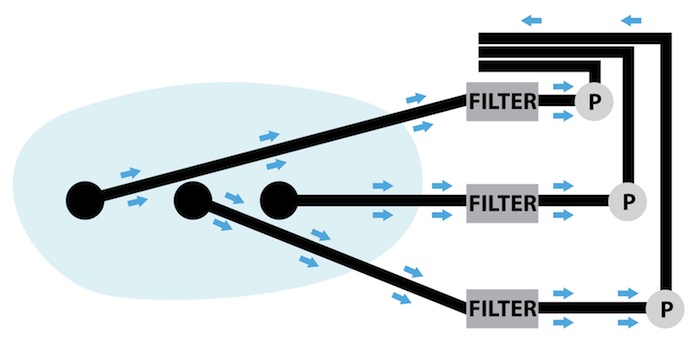One Drain To One Filter To One Pump Principle
Right now, a perfect large pond is merely a series of perfect smaller ponds – hopefully of reasonably equal proportions, please bear this in mind even though it is pure common sense. All this should be taken into account in the initial planning and design stages. This principle above, I brought out in 1991 when designing my own pond at home. The pond started up in 1999 and has been running perfectly ever since on this same principle and, whilst some filtration ideas have moved on tremendously since then, the above principle of ‘One drain to one filter to one pump’ is still the ONLY way to go as of now. Here are a few reasons why.
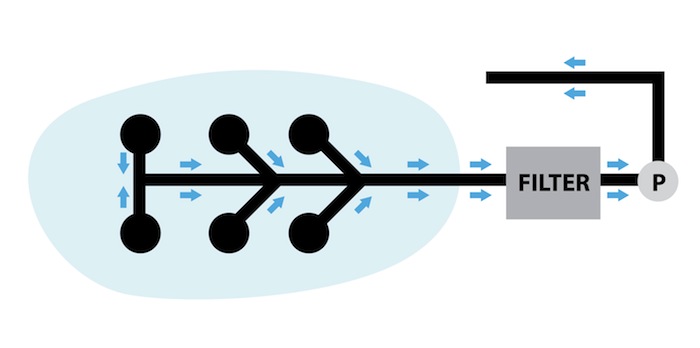 This is an old chestnut first dreamed up by some idiot who desperately had to off-load a few drains together with a load of expensive fittings. In this case, providing the two drains nearest the filter are EXACTLY at the same depth and distance of travel (which is almost impossible) then they will each supply around 50% of the water to the filter by head. The other four do nothing at all except gather stagnant water around them – in short, completely useless – and very expensive.
This is an old chestnut first dreamed up by some idiot who desperately had to off-load a few drains together with a load of expensive fittings. In this case, providing the two drains nearest the filter are EXACTLY at the same depth and distance of travel (which is almost impossible) then they will each supply around 50% of the water to the filter by head. The other four do nothing at all except gather stagnant water around them – in short, completely useless – and very expensive.
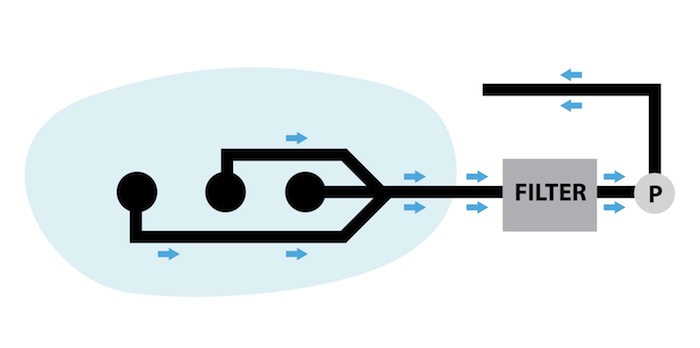 Here’s another classic cock-up, the only drain working here is the one nearest the filter the other two are for aesthetics only. They may be of marginal satisfaction in saying ‘Oh yes, I have a three-drain system’ but it goes no further than that. Please take my word for this from many years of experience.
Here’s another classic cock-up, the only drain working here is the one nearest the filter the other two are for aesthetics only. They may be of marginal satisfaction in saying ‘Oh yes, I have a three-drain system’ but it goes no further than that. Please take my word for this from many years of experience.
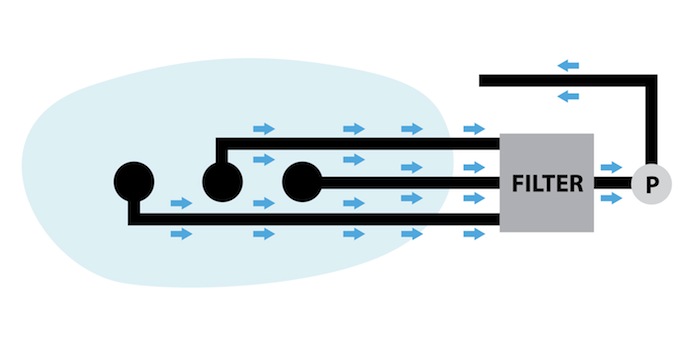 This shows ‘an improvement’ without doubt, but still a very real ‘compromise’ nonetheless. Any real operation using this design can only be achieved by fitting an in-line valve to all three lines before they enter the filter. To ensure we get some kind of efficiency from this layout , we need to close two valves for one day and allow only one to operate. The following day, close the first valve and open one other and so on to ensure only one drain operates in a given day. It is not perfect by any means but light-years ahead of the first two previous examples. In view of the fact that I probably ‘invented’ this type of layout in the late 1980’s in an attempt to improve over earlier and useless methods, in truth I failed yet again as the design is still flawed. I finally resolved all of this in 1991 with the following design mentioned next.
This shows ‘an improvement’ without doubt, but still a very real ‘compromise’ nonetheless. Any real operation using this design can only be achieved by fitting an in-line valve to all three lines before they enter the filter. To ensure we get some kind of efficiency from this layout , we need to close two valves for one day and allow only one to operate. The following day, close the first valve and open one other and so on to ensure only one drain operates in a given day. It is not perfect by any means but light-years ahead of the first two previous examples. In view of the fact that I probably ‘invented’ this type of layout in the late 1980’s in an attempt to improve over earlier and useless methods, in truth I failed yet again as the design is still flawed. I finally resolved all of this in 1991 with the following design mentioned next.
This is, in a word, ‘perfection’ if there is ever such a word, and so damned obvious it is pointless even thinking about any other suggestions and possibilities. It is the only way I know of to ensure all drains are carrying out their work perfectly 24/7. Obviously, to get exactly equal performance from all drains, the pumps should all be delivering the same amount of water per hour back to the pond. I came up with this outrageous notion in 1991 when I used it in the design of my own pond at home.
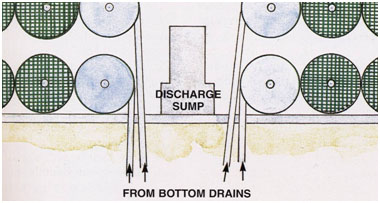 I published this ‘outrageous’ (as were the comments it produced) idea in 1995 for all to see in ‘Koi Kichi’ under the heading of ‘Tomorrow’s World’ and here is a section of the illustration. From feedback and some conversations over the past 14 years or so, it is clear that, whilst many have owned the book, there are also many who have not actually ‘read’ this section of it.
I published this ‘outrageous’ (as were the comments it produced) idea in 1995 for all to see in ‘Koi Kichi’ under the heading of ‘Tomorrow’s World’ and here is a section of the illustration. From feedback and some conversations over the past 14 years or so, it is clear that, whilst many have owned the book, there are also many who have not actually ‘read’ this section of it.
The entire base of my pond is being vacuumed 24/7 and remains that way without any attention at all. I also have the choice, if necessary when low stocking rates are present, to alternate each of the four filter systems by timer to bring one or more ‘banks’ out of the operation for a day or so and then the timer shuts them off and opens the others for another equal time period. The obvious savings on electricity usage can be considerable.
As a matter of interest I trialled this system some months ago using one different bank of filters only by switching the other three pumps off and alternating them daily, still only using one bank. Obviously this was not perfection by any means but it was not exactly ‘too far away from the real thing’ and also reduced my ‘filtration electricity costs’ by around 75% in my case. As a result of all this, a large-volume pond becomes a combination of several very efficient smaller ponds thus providing perfection as of now.

